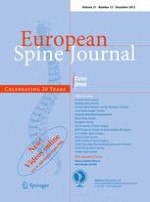Published in:

01-12-2012 | Ideas and Technical Innovations
Validation of a novel spinal posture monitor: comparison with digital videofluoroscopy
Authors:
Kieran O’Sullivan, Sabine Verschueren, Steven Pans, David Smets, Karel Dekelver, Wim Dankaerts
Published in:
European Spine Journal
|
Issue 12/2012
Login to get access
Abstract
Purpose
A novel, minimally invasive posture monitor which can monitor lumbar postures outside the laboratory has demonstrated excellent reliability, as well as concurrent validity compared to a surface marker-based motion analysis system. However, it is unclear if this device reflects underlying vertebral motion.
Methods
Twelve participants performed full range sagittal plane lumbo-pelvic movements during sitting and standing. Their posture was measured simultaneously using both this device (BodyGuard™) and digital videofluoroscopy.
Results
Strong correlations were observed between the two methods (all r
s > 0.88). Similarly, the coefficients of determination were high (all r
2 > 0.78). The maximum mean difference between the measures was located in the mid-range of motion and was approximately 3.4° in sitting and 3.9° in standing.
Conclusion
The BodyGuard™ appears to be a valid method for analysing vertebral motion in the sagittal plane and is a promising tool for long-term monitoring of spinal postures in laboratory and clinical settings in people with low back pain.